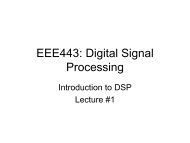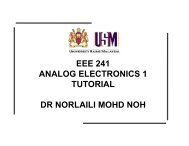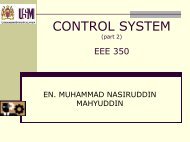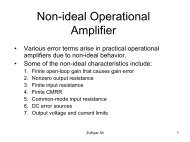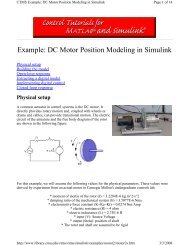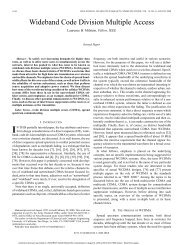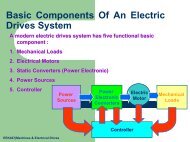Digital Controller Design - School Of Electrical & Electronic ...
Digital Controller Design - School Of Electrical & Electronic ...
Digital Controller Design - School Of Electrical & Electronic ...
Create successful ePaper yourself
Turn your PDF publications into a flip-book with our unique Google optimized e-Paper software.
Motivation and Overview<br />
Compensation<br />
DIGITAL CONTROL SYSTEM<br />
EEE354<br />
<strong>Digital</strong> <strong>Controller</strong> <strong>Design</strong><br />
MUHAMMAD NASIRUDDIN MAHYUDDIN<br />
<strong>School</strong> of <strong>Electrical</strong> and <strong>Electronic</strong> Engineering,<br />
UNIVERSITI SAINS MALAYSIA<br />
week 13<br />
Semester II 2007/2008<br />
nasiruddin@eng.usm.my EEE 354 : DIGITAL CONTROLLER DESIGN
Outline<br />
Motivation and Overview<br />
Compensation<br />
week 13: 10/03/2008 - 15/03/2008<br />
1 Motivation and Overview<br />
2 Compensation<br />
Phase-Lag Compensation<br />
Phase-Lead Compensation<br />
nasiruddin@eng.usm.my EEE 354 : DIGITAL CONTROLLER DESIGN
Motivation and Overview<br />
Compensation<br />
Overview of system performance specification<br />
The desired characteristic or performance specification generally<br />
relate to:<br />
steady-state accuracy<br />
transient response<br />
relative stability<br />
sensitivity to change in system parameters<br />
nasiruddin@eng.usm.my EEE 354 : DIGITAL CONTROLLER DESIGN
Motivation and Overview<br />
Compensation<br />
Steady state accuracy<br />
The steady state accuracy is increased if poles at z=1 are added to<br />
the open-loop function and/or if the open loop gain is increased.<br />
However, added poles at z=1 in the open loop function introduce<br />
phase lag into the open loop frequency response, resulting in<br />
reduced stability margins.<br />
The control system design is usually a trade-off between steady state<br />
accuracy and acceptable relative stability.<br />
nasiruddin@eng.usm.my EEE 354 : DIGITAL CONTROLLER DESIGN
Motivation and Overview<br />
Compensation<br />
Transient Response<br />
Typical performance criteria are:-<br />
rise time t r<br />
peak overshoot or peak magnitude M p<br />
resonance peak M r<br />
time-to-peak overshoot t p<br />
settling time t s<br />
nasiruddin@eng.usm.my EEE 354 : DIGITAL CONTROLLER DESIGN
Motivation and Overview<br />
Compensation<br />
transient response<br />
The transient system is related to system bandwidth.<br />
To decrease the tise time and increase speed of response, the<br />
system bandwidth must be increased. However, if significant<br />
high-frequency noise sources are present in the system.<br />
A trade-off must be made between a fast rise time and an acceptable<br />
response.<br />
nasiruddin@eng.usm.my EEE 354 : DIGITAL CONTROLLER DESIGN
Motivation and Overview<br />
Compensation<br />
Characteristic of second-order system<br />
nasiruddin@eng.usm.my EEE 354 : DIGITAL CONTROLLER DESIGN
Motivation and Overview<br />
Compensation<br />
Characteristic of second-order system<br />
Given a second order LTI analog system with transfer function<br />
T(s) =<br />
2<br />
ω n<br />
s 2 +2ζω ns+ω 2 n<br />
which has unit step response, the following<br />
characteristic can be obtained:<br />
√ −ζπ<br />
M p = 1 + e<br />
1−ζ 2<br />
1<br />
M r = √<br />
2ζ 1−ζ<br />
(1)<br />
2<br />
ω n t p<br />
π<br />
= √<br />
1<br />
1−ζ 2<br />
Rule of thumb: resonance peak, M r is set at 2 dB in order to have<br />
suitable peak magnitude, M p . Peak magnitude will have an effect on<br />
the overshoot of the system.<br />
nasiruddin@eng.usm.my EEE 354 : DIGITAL CONTROLLER DESIGN
Motivation and Overview<br />
Compensation<br />
Relative stability<br />
The stability margins (gain margins and phase margins) are related to<br />
peak overshoot M p .<br />
The phase margin can be expressed as,<br />
[<br />
]<br />
φ m = tan −1 q<br />
2ζ √<br />
4ζ 4 +1−2ζ 2<br />
nasiruddin@eng.usm.my EEE 354 : DIGITAL CONTROLLER DESIGN
Sensitivity<br />
Motivation and Overview<br />
Compensation<br />
We prefer that the control system characteristics do not vary as<br />
certain parameters in the system vary due to change in temperature,<br />
humidity, altitude, age and so on. This is due to the fact that the<br />
system characteristic are a function of the system parameters.<br />
A closed-loop transfer function of a discrete system is given by<br />
T(s) =<br />
G(z)<br />
1+G(z)<br />
Sensitivity to a parameter a, is normally defined as a measure of the<br />
percentage change in T(z) to a percentage change in parameter a.<br />
∆T/T<br />
One such definition is sensitivity ≈<br />
∆a/a = ∆T a<br />
∆a T<br />
nasiruddin@eng.usm.my EEE 354 : DIGITAL CONTROLLER DESIGN
Sensitivity<br />
Motivation and Overview<br />
Compensation<br />
∆T is the variation in T caused by ∆a, the variation in parameter a.<br />
Now, we are to find the sensitivity of T with respect to G for a discrete<br />
system:<br />
SG T = ∂T G<br />
∂G<br />
T = 1+G(z)−G(z) G(z)<br />
[1+G(z)] 2 G(z)/[1+G(z)] = 1<br />
1+G(z)<br />
At the frequency ω, we let z = e jωT , and<br />
S T G = 1<br />
1+G(e j ωT)<br />
For this sensitivity to be small within the system bandwidth, we<br />
require that G(e jωT >> 1<br />
Therefore, we can reduce the sensitivity of T to G by increasing<br />
the open loop gain. However, this action will cause stability<br />
problems. Again, a trade-off is there to decide.<br />
nasiruddin@eng.usm.my EEE 354 : DIGITAL CONTROLLER DESIGN
Motivation and Overview<br />
Compensation<br />
Disturbance Rejection<br />
Figure 2: Discrete Control System<br />
In the system shown in Figure 2, F(s) is a disturbance. Since R(s) is<br />
the control input, we design the system such that c(t) is approx equal<br />
to r(t). If F is zero, then<br />
C(z) =<br />
D(z)G 1G 2 (z)<br />
1+D(z)G 1 G 2 (z)R(z)<br />
nasiruddin@eng.usm.my EEE 354 : DIGITAL CONTROLLER DESIGN
Motivation and Overview<br />
Compensation<br />
Disturbance Rejection<br />
hence, in terms of frequency response, we require that<br />
D(e jωT )G 1 G 2 (e jωT ) >> 1<br />
over the desired system bandwidth. Then, C(e jωT ) ≈ R(e jωT )<br />
If we consider only the disturbance input in Figure 2, then,<br />
C(z) =<br />
G 2 F(z)<br />
1+D(z)G 1 G 2 (z)<br />
hence, over the desired system bandwidth,<br />
C(e jωT ) ≈<br />
G 2 F(e jωT )<br />
D(e jωT )G 1 G 2 (e jωT )<br />
nasiruddin@eng.usm.my EEE 354 : DIGITAL CONTROLLER DESIGN
Disturbance<br />
Motivation and Overview<br />
Compensation<br />
Referring to the previous slide, the disturbance response will be<br />
small since the denominator of the expression<br />
is large. Disturbance rejection for the system shown is good<br />
provided we have a high loop gain not occuring at the direct path<br />
between the disturbance input and the system output.<br />
nasiruddin@eng.usm.my EEE 354 : DIGITAL CONTROLLER DESIGN
Control Effort<br />
Motivation and Overview<br />
Compensation<br />
Any physical motor will have a maximum torque that can be<br />
developed. If we can this control effort (the torque) u(t), then |u(t)| will<br />
be bounded. Usually the system to be controlled is simulated without<br />
considering this limitation on the control effort. Then, worst-case<br />
condition is included in the simulation including considering the real<br />
physical characteristic of the motor (or any other actuator).<br />
nasiruddin@eng.usm.my EEE 354 : DIGITAL CONTROLLER DESIGN
Compensation<br />
Motivation and Overview<br />
Compensation<br />
Phase-Lag Compensation<br />
Phase-Lead Compensation<br />
We will learn how to design compensator limited to SISO<br />
system. The compensators to be learnt are the followings:<br />
Phase-Lag Compensator<br />
Phase-Lead Compensator<br />
Lead-Lag Compensator (sekiranya ada masa)<br />
In this chapter, Bode Plot will be used as a tool to design our digital<br />
compensators in frequency response. Therefore, my students are<br />
encouraged to review back steps/procedure in drawing bode plot<br />
correctly. <strong>Controller</strong> <strong>Design</strong> via root locus is not covered.<br />
nasiruddin@eng.usm.my EEE 354 : DIGITAL CONTROLLER DESIGN
Motivation and Overview<br />
Compensation<br />
Phase-Lag Compensator<br />
Phase-Lag Compensation<br />
Phase-Lead Compensation<br />
The transfer function of the phase-lag controller in w-domain:<br />
D lag (w) = K α<br />
w+ω h<br />
w+ω l<br />
,<br />
ω l
Motivation and Overview<br />
Compensation<br />
Phase-Lag Compensator<br />
Phase-Lag Compensation<br />
Phase-Lead Compensation<br />
Figure 3: phase-lag compensator<br />
ω l : low break frequency<br />
ω h : high break frequency.<br />
nasiruddin@eng.usm.my EEE 354 : DIGITAL CONTROLLER DESIGN
Motivation and Overview<br />
Compensation<br />
Phase-Lag Compensation<br />
Phase-Lead Compensation<br />
Procedure to design Phase-Lag Compensator<br />
1 Set the gain K, to the value that satisfies the steady-state error<br />
requirement.<br />
2 Obtain the bode plot using the value of the gain K as defined in<br />
Step 1.<br />
3 Calculate using the formula relating the phase margin with the<br />
transient response specifications.<br />
recap<br />
[<br />
]<br />
φ m = tan −1 q √<br />
2ζ<br />
4ζ 4 +1−2ζ 2<br />
nasiruddin@eng.usm.my EEE 354 : DIGITAL CONTROLLER DESIGN
Motivation and Overview<br />
Compensation<br />
Phase-Lag Compensation<br />
Phase-Lead Compensation<br />
Procedure to design Phase-Lag Compensator<br />
4 Determine the required additional phase φ Mlag to be<br />
contributed by the phase-lag controller in order to satisfy<br />
Step 3 as follows:<br />
φ Mlag = φ Mcomp + φ<br />
φ is the correcting factor to compensate for the phase angle<br />
contribution of the lag compensator. Normally, the correcting factor<br />
within the region of 5 ◦ ≤ φ ≤ 12 ◦ is used. This is due to the fact that<br />
the phase angle contribution of the lag compensator may still<br />
contribute anywhere from −5 ◦ ≤ φ ≤ −12 ◦ of phase at the gain<br />
crossover frequency.<br />
nasiruddin@eng.usm.my EEE 354 : DIGITAL CONTROLLER DESIGN
Motivation and Overview<br />
Compensation<br />
Phase-Lag Compensation<br />
Phase-Lead Compensation<br />
Procedure to design Phase-Lag Compensator<br />
5 Determine the gain crossover frequency f g (rad/s) from the bode<br />
plot which yield φ Mlag . At this frequency, f g , the magnitude plot<br />
must cross the 0 dB line.<br />
6 Determine the magnitude G M (dB) at the gain cross over<br />
frequency f g rad/s from the magnitude plot. Thus, the lag<br />
compensator must contribute −G M dB attenuation so that the<br />
magnitude plot will cross the 0 dB line at f g .<br />
7 Draw the high frequency asymptote of the lag compensator at<br />
−G M dB. Select the higher break frequency about one decade<br />
below the gain crossover frequency f g , that is, ω h = 0.1f g rad/s.<br />
Draw a -20 dB/decade line starting at the intersection of the<br />
higher break frequency ω h with the lag compensator’s high<br />
frequency asymptote until the 0dB line.<br />
nasiruddin@eng.usm.my EEE 354 : DIGITAL CONTROLLER DESIGN
Motivation and Overview<br />
Compensation<br />
Phase-Lag Compensation<br />
Phase-Lead Compensation<br />
Procedure to design Phase-Lag Compensator<br />
8 Locate the lag’s compensator’s lower break frequency ω l at the<br />
intersection of the -20dB/decade line with the 0 dB line. Hence,<br />
the phase-lag compensator’s transfer function is given in the<br />
form of equation.<br />
D lag (w) = K α<br />
w+ω h<br />
w+ω l<br />
,<br />
ω l
Motivation and Overview<br />
Compensation<br />
Phase-Lag Compensation<br />
Phase-Lead Compensation<br />
Procedure to design Phase-Lag Compensator<br />
Figure 4: Bode plot of uncompensated system and the phase-lag<br />
compensator<br />
nasiruddin@eng.usm.my EEE 354 : DIGITAL CONTROLLER DESIGN
Motivation and Overview<br />
Compensation<br />
Phase-Lead Compensator<br />
Phase-Lag Compensation<br />
Phase-Lead Compensation<br />
The transfer function of the phase-lead controller in w-domain will be<br />
of the form:<br />
D lead (w) = 1 β<br />
(<br />
w+ωl<br />
w+ ω l<br />
β<br />
)<br />
=<br />
( )<br />
w+ω<br />
K l<br />
β w+ω h<br />
, ω l
Motivation and Overview<br />
Compensation<br />
Phase-Lead Bode plot<br />
Phase-Lag Compensation<br />
Phase-Lead Compensation<br />
Figure 5: Bode plot of the phase lead compensator<br />
nasiruddin@eng.usm.my EEE 354 : DIGITAL CONTROLLER DESIGN
Motivation and Overview<br />
Compensation<br />
Phase-Lag Compensation<br />
Phase-Lead Compensation<br />
Procedure to design phase-lead controller<br />
1 Set the gain K for the uncompensated system to a value<br />
satisfying the steady state error<br />
2 Draw the bode plot using the value of K above and determine<br />
the uncompensated system phase margin, φ Muncomp .<br />
3 Calculate the closed-loop bandwidth, ω b required to meet the<br />
transient response requirement using correct formula.<br />
4 Calculate the phase angle, φ Mcomp required to meet the damping<br />
ratio or percentage overshoot requirement.<br />
5 Determine the additional phase contribution φ Mlead required from<br />
the phase-lead compensator, in order to meet the desired phase<br />
angle,<br />
φ Mlead<br />
= φ Mcomp − φ Muncomp + φ<br />
φ is normally set at 10 ◦ , a correction factor to compensate for the lower uncompensated system’s phase angle at<br />
this higher phase-margin frequency.<br />
nasiruddin@eng.usm.my EEE 354 : DIGITAL CONTROLLER DESIGN
Motivation and Overview<br />
Compensation<br />
Phase-Lag Compensation<br />
Phase-Lead Compensation<br />
Procedure to design phase-lead controller<br />
6 Determine the value of β from the phase lead compensator’s<br />
required phase margin as follows:<br />
[ ] [ ]<br />
φ Mlead = tan −1 1−β<br />
2 √ = sin −1 1−β<br />
β<br />
1+β<br />
7 Determine the compensator’s magnitude at the peak of the<br />
phase curve using the following formula:<br />
|G lead (jω max )| = 1 √ β<br />
nasiruddin@eng.usm.my EEE 354 : DIGITAL CONTROLLER DESIGN
Motivation and Overview<br />
Compensation<br />
Phase-Lag Compensation<br />
Phase-Lead Compensation<br />
Procedure to design phase-lead controller<br />
8 Determine the new gain crossover frequency ω max on the Bode<br />
plot by finding where the uncompensated system’s curve is the<br />
negative value of |G lead (jω max )| as obtained above. At this<br />
frequency ω max , the uncompensated system’s magnitude plot<br />
must cross the 0 dB line. Since, the compensator’s magnitude<br />
contributes |G lead (jω max )|dB at this frequency, the uncompensated<br />
system’s magnitude curve must be −|G lead (jω max )|dB at this<br />
frequency.<br />
9 Calculate the phase-lead compensators break frequencies ω l<br />
and ω h using the following formula:<br />
ω max = ωl √ β<br />
nasiruddin@eng.usm.my EEE 354 : DIGITAL CONTROLLER DESIGN
Motivation and Overview<br />
Compensation<br />
Phase-Lag Compensation<br />
Phase-Lead Compensation<br />
Procedure to design phase-lead controller<br />
10 The phase-lead compensator’s transfer function is given in the<br />
form of,<br />
( ) (<br />
)<br />
D lead (w) = 1 w+ω l<br />
w+ω<br />
β w+ ω l = K l β w+ω<br />
β<br />
h<br />
, ω l



